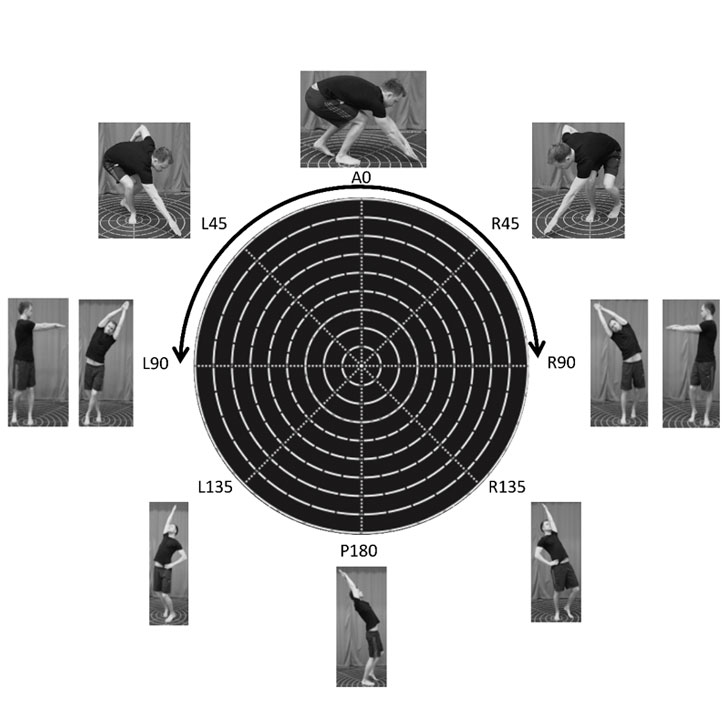
Jesse Joronen is the football player. He is the goalkeeper for FC København football club, and he has the plumb line hanging from the end of his middle finger. He has struggled with numerous injuries and needs to work out how to move better. This kind of knowledge is absolutely essential for a goalkeeper. He has just arrived, taking the early morning flight from Copenhagen, to get help. And now, he’s being measured.
May be useful
The purpose of the measurements or tests is to discover how much movement he actually has when compared with how much movement he should have, and to provide some advice on what he can do so that he can literally stretch a bit further.
—It really is quite simple, but can be very useful. For the time being, we’re not quite sure how though, says Ola Eriksrud. He is a research fellow with the Department of Physical Performance (SFP) at the Norwegian School of Sport Sciences (NIH). His public defence of the measurement method he has developed for his doctoral degree is scheduled to take place just before Midsummer Day.
When asked, he says that his measurement device can be compared to a ruler. It is a simple object, but can be used for so many different purposes as long as you know how.
Star test for top athletes and the elderly
Ola’s “instrument” is made up of a mat displaying what looks like a bull’s eye. It features a 360-degree protractor with concentric circles graduating out from the centre and with angle specifications all the way around. The instrument also comprises a plumb line used to take measurements above the mat.
—I’m sure there’s some fancy instrument you could develop using electronics, but a mat and a plumb line are so simple, accurate and can be used anywhere. They are also very easy to transport, says Ola Eriksrud. The testing method has been cryptically named “Hand reach star excursion balance test” (HSEBT).
The main purpose of the new method is to measure how far a person can move in different directions, so that you can provide guidance on how, for example, that person should exercise or stretch to improve range of movement and thereby performance. It is very beneficial for both top athletes and the elderly, who are a bit unsteady on their feet. We will talk more about the latter soon.
Issues revealed by patterns

Right now, Jesse Joronen has his right heel in the central ring, his left foot slightly behind toe to heel and he is stretching as far as he can, first with his left hand at 45 degrees forwards to the right, then vice versa. He repeats the movement backwards, while Ola Eriksrud makes adjustments to the position of his back and hips.
The test procedures are important. By applying one single standard, other testers can repeat the exercises and achieve comparable measurements.
The end result of the measurements is a set of mobility scores. In total, these provide a pattern or profile illustrating the ability to move in different directions – and the ability to control movement (so-called dynamic postural control). The results shall be easy to understand, even for the athletes.
—Absolutely. When we carried out the tests on one of our top downhill skiers, we discovered that she had an impaired ability to rotate her hips. In collaboration with a couple of coaches, we decided that we had to improve her mobility and control before we could move on to working on strength and speed.
—This has proven to be valuable. Why is it that an athlete cannot achieve one movement or another? What is the level of impairment to the actual mobility, and the control the athlete has over mobility? What’s holding the athlete back? The tests make it much easier to find connections, limitations – and of course, opportunities.
Totality important
Ola Eriksrud’s decision to develop the measurement method was inspired by pure frustration: He was studying physiotherapy, and all the tests he had learned only provided information on one single joint.
—It doesn’t matter how much you bend or stretch an ankle, knee or hip, this doesn’t translate into running, walking or high jumps. You need a much more comprehensive approach. The whole is much larger than its constituent parts or, at least, the different parts have to be seen as a part of the whole, claims Ola Eriksrud.
Another part of the whole is the experiences of the athlete. The measurement results for Jesse Joronen show that he has a poorer reach on one side when compared with the other, and this explains why he is slower to move to the right than to the left.
—So roughly the same pattern in two people can give completely different conclusions?
—Yes, because they have different backgrounds. So, you have to take their experiences into account, make it subjective, says Ola Eriksrud.
Can be used to help the elderly
After testing the method multiple times, Ola Eriksrud believes he has identified common patterns within different types of sports. However, mobility also depends on both gender and age.
And now that we have mentioned age: Ola is confident that his method can be of value for everyone, from both young, talented athletes to the elderly, for whom a fall could potentially cause severe injuries.
—Let’s say that we perform tests on Mr. Hansen, an elderly gentleman, to detect his reach and balance. The tests will show where he has problems and which exercises he can do to help him become more steady on his feet. If these exercises save him, for example, from breaking his upper femur, then he will avoid a severe injury with all that entails, and society will be saved major costs.
Ola Eriksrud also hopes that the tests can help prevent injuries in younger people.
—By taking several tests over time and comparing them both with each other and with a 'normal' average, you can detect changes and stop something from developing too far in the wrong direction.
Promising for numerous sports
Jesse Joronen, from Finland, is far from the only sportsman to be tested. Olympiatoppen has already adopted the method and used it for a number of sports both at home and abroad.
—As use increases, we are beginning to find many examples of how the method can be of use. It all seems very promising. And it’s kind of cool that it’s so simple. All you have to do is learn the procedure. The rest is analogue and easy to understand.
FACTS: Hand reach star excursion balance test (HSEBT)
≈ A test for reach, mobility and balance
- A newly developed, standardised test that measures how far you can stretch your hands in different directions ("star shape") while retaining full balance.
- Reach is measured as both angle and distance: With one foot placed in the middle of the "bull’s eye", you stretch in specific directions/angles above a protractor. The farther you can stretch, the better.
- By comparing the reach of the right and left hand and foot respectively, limitations are uncovered but these can also be measured accurately – in centimetres from the centre of the bull’s eye.
- And by comparing measured mobility with any problems an athlete has, you can both detect the position of, for example, an injury and find out how much this limits the athlete, in addition to providing more solid foundations for exercises or treatment.
